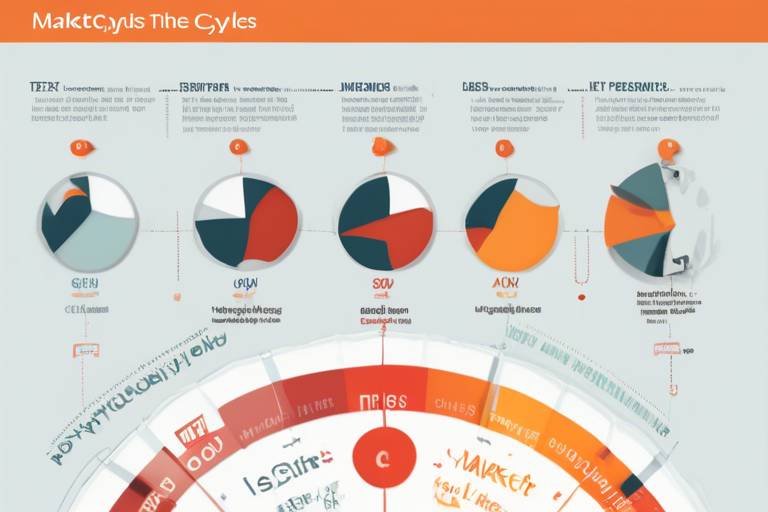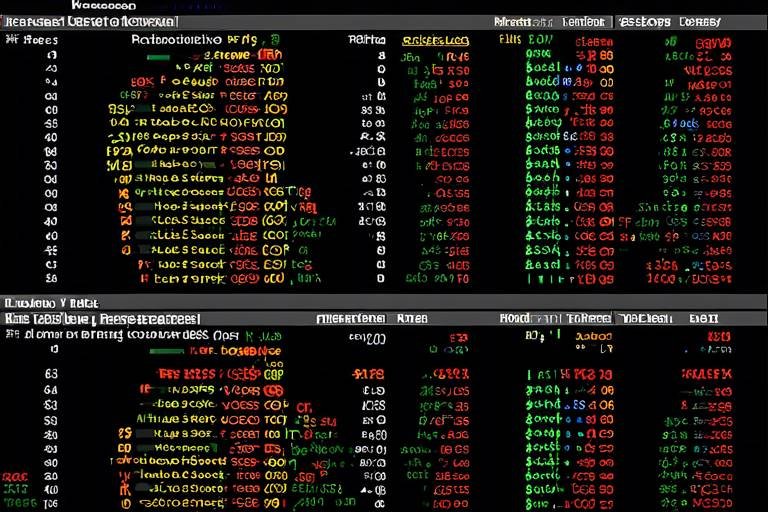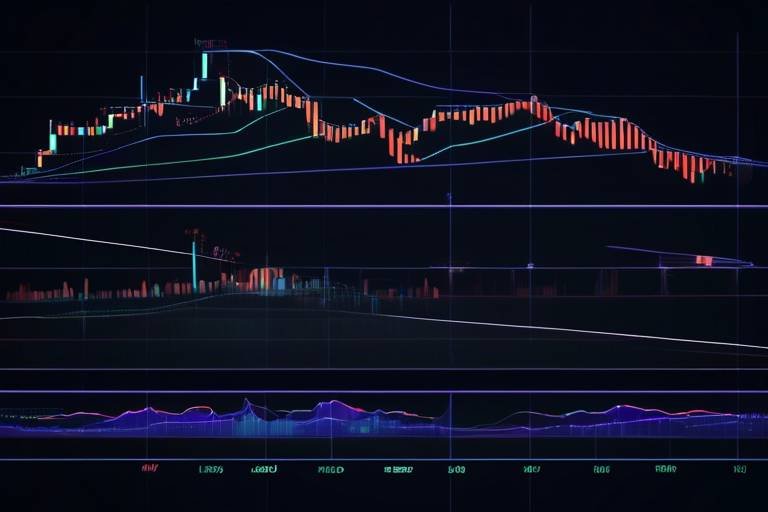Understanding the Psychology Behind Market Cycles
When we dive into the world of finance, it's easy to get lost in numbers, charts, and complex theories. However, at the heart of every market cycle lies a fascinating aspect that often gets overlooked: human psychology. You see, markets are not just driven by cold, hard data; they are profoundly influenced by the emotions and behaviors of the investors navigating them. Understanding this intricate dance between psychology and market cycles can be the key to unlocking better investment strategies and decision-making.
Market cycles, characterized by periods of expansion and contraction, are not merely economic phenomena; they are reflections of collective human sentiment. Imagine a roller coaster ride, with investors screaming in excitement during the highs and holding their breath in fear during the lows. This emotional roller coaster is what drives market trends, often leading to irrational behaviors that can cause significant deviations from fundamental values. So, what exactly fuels these emotional responses? Let's explore.
Investor sentiment is like the weather in the financial world; it can change rapidly and unexpectedly. During bullish phases, optimism reigns supreme, and investors are more likely to take risks, pushing prices higher. Conversely, in bearish markets, fear can take over, leading to panic selling. This collective emotional state is influenced by various factors, including news reports, economic indicators, and even social media chatter. Understanding how sentiment shifts can help investors anticipate market movements and adjust their strategies accordingly.
Take, for example, the impact of social media on today's markets. With a single tweet, a stock can skyrocket or plummet, driven by the emotions of thousands of investors reacting in real-time. This phenomenon isn't new; it's simply a modern twist on a timeless truth: emotions drive decisions. Recognizing the power of investor sentiment can empower traders to make more informed choices, rather than succumbing to the whims of the crowd.
As we navigate the complexities of market cycles, it's essential to understand the cognitive biases that can cloud our judgment. Two significant biases that often come into play are overconfidence and loss aversion. These biases can lead investors down a treacherous path, making decisions that may seem rational at the moment but are often detrimental in the long run.
Overconfidence bias is a classic example of how our minds can betray us. When investors overestimate their knowledge or predictive abilities, they tend to take on excessive risks. This can create a false sense of security, leading to market bubbles where investors ignore warning signs. Imagine a group of friends at a party, each convinced they know the best dance moves; their overconfidence might lead them to take the dance floor by storm, only to realize they are out of sync with the music—and the crowd.
The ramifications of overconfidence in trading can be significant. Investors may hold onto losing positions, convinced that the market will turn in their favor, or chase after high-risk assets, hoping for a quick win. This behavior not only affects individual portfolios but can also contribute to broader market instability. Recognizing the signs of overconfidence is crucial for maintaining a balanced investment strategy.
To combat overconfidence, investors can adopt strategies such as setting strict risk limits and regularly reviewing their performance. Self-awareness is key here; acknowledging that we are all prone to biases can lead to more rational decision-making. By keeping emotions in check and focusing on data-driven analysis, investors can navigate the market more effectively.
Loss aversion is another powerful psychological force that shapes investor behavior. It describes our innate tendency to prefer avoiding losses rather than acquiring equivalent gains. Think of it this way: losing $100 feels much worse than the joy of gaining $100. This bias can lead to irrational decision-making, especially during market downturns when fear overrides logic. Investors may sell off assets at a loss, hoping to avoid further declines, rather than holding onto them for potential future recovery.
Market news serves as a catalyst for investor sentiment, often amplifying psychological effects. The way news is presented can significantly shape perceptions, leading to herd behavior where individuals mimic the actions of a larger group. This phenomenon can exacerbate the swings of market cycles, reinforcing trends of boom and bust.
Herd behavior is like a stampede; when one investor reacts to news, others follow suit, often disregarding their own analysis. This collective action can lead to rapid market movements, creating bubbles or crashes driven by emotion rather than fundamentals. It's a reminder that sometimes, the crowd can lead us astray.
The framing of financial news plays a crucial role in shaping investor perceptions. Sensational headlines can evoke strong emotional responses, influencing decision-making in ways that may not align with rational analysis. Understanding how media can sway our emotions is essential for recognizing its impact on market psychology and cycles.
To gain a deeper understanding of market cycles, we can look to history. By examining past behaviors, we can identify recurring psychological patterns that inform our current trends. For instance, the dot-com bubble of the late 1990s and the financial crisis of 2008 both highlight how psychological factors influenced investor behavior and market outcomes.
In conclusion, the psychology behind market cycles is a complex interplay of emotions, cognitive biases, and external influences. By understanding these factors, investors can navigate the markets more effectively, making informed decisions that are less swayed by fear and greed.
- What is investor sentiment? Investor sentiment refers to the overall attitude of investors toward a particular market or asset, often influenced by emotions and external factors.
- How do cognitive biases affect trading? Cognitive biases can lead to poor decision-making, as investors may overestimate their knowledge or fear losing money, impacting their trading strategies.
- What is herd behavior in markets? Herd behavior occurs when investors follow the actions of a larger group, often leading to irrational market movements.
- How can I mitigate overconfidence in my trading? Implementing disciplined strategies, setting risk limits, and regularly reviewing performance can help reduce the effects of overconfidence.

The Role of Investor Sentiment
Investor sentiment is a powerful force that drives market cycles, often leading to trends that can seem irrational at times. When we talk about sentiment, we're referring to the collective emotions and attitudes of investors towards the market or specific assets. Think of it as the mood of the market—when investors are feeling optimistic, they tend to buy more, pushing prices up. Conversely, when fear and pessimism take hold, selling ensues, leading to price declines. This emotional rollercoaster can create significant deviations from what fundamental analysis might suggest.
To illustrate this concept, consider the following factors that contribute to investor sentiment:
- Market Trends: A rising market can create a sense of euphoria, where investors feel invincible and chase after gains, often ignoring risks.
- Economic Indicators: Positive economic news, such as low unemployment rates or rising GDP, can boost sentiment, while negative reports can dampen enthusiasm.
- Social Media Influence: In today's digital age, social media can rapidly spread information (and misinformation), significantly impacting how investors feel about market conditions.
Understanding these emotional drivers is crucial for investors. It explains why markets can sometimes behave in ways that seem disconnected from underlying economic realities. For example, during a bull market, investor optimism can lead to inflated asset prices, creating a bubble. On the flip side, during a bear market, fear can lead to panic selling, pushing prices down further than they might otherwise go. This cycle of emotion-driven behavior can result in significant volatility, making it essential for investors to remain aware of their own emotional responses.
Moreover, investor sentiment is often contagious. When one investor feels bullish and shares that sentiment, it can influence others to jump on the bandwagon, leading to herd behavior. This collective mindset can accelerate market movements, reinforcing the cycle of booms and busts. By recognizing the role of sentiment, investors can better navigate the complexities of the market and make more informed decisions.
In summary, investor sentiment is a critical component of market cycles. It acts like a pendulum, swinging between extremes of optimism and pessimism, often leading to irrational market behaviors. By understanding the psychological factors at play, investors can position themselves more strategically, avoiding the pitfalls of emotional trading and potentially capitalizing on market inefficiencies.

Cognitive Biases in Trading
Cognitive biases are like invisible glasses that influence how investors perceive the market and make decisions. These biases can lead to irrational behavior, often resulting in poor trading outcomes. One of the most significant biases is overconfidence, where traders believe they have superior knowledge or skills compared to others. This inflated self-assessment can lead to excessive risk-taking, as investors ignore warning signs and cling to unrealistic expectations. For instance, when a trader experiences a string of successful trades, they may feel invincible, leading them to invest larger sums in volatile assets without proper analysis.
Another critical bias is loss aversion, which describes the tendency of investors to prefer avoiding losses rather than acquiring equivalent gains. Imagine walking on a tightrope; the fear of falling (loss) often overshadows the potential reward of reaching the other side (gains). This psychological trait can lead to emotional decision-making during market downturns, causing investors to hold onto losing positions in the hope that prices will rebound, rather than cutting their losses and reallocating their capital to more promising opportunities.
To further illustrate how cognitive biases can impact trading behavior, consider the following table that highlights common cognitive biases and their effects:
| Cognitive Bias | Description | Impact on Trading |
|---|---|---|
| Overconfidence Bias | Overestimation of one's knowledge or predictive abilities. | Excessive risk-taking and ignoring warning signs. |
| Loss Aversion | Preference for avoiding losses over acquiring gains. | Holding onto losing positions and irrational decision-making. |
| Confirmation Bias | Seeking information that confirms existing beliefs. | Ignoring contradictory evidence, leading to poor investment choices. |
| Anchoring | Relying too heavily on the first piece of information encountered. | Inability to adjust expectations based on new data. |
Understanding these biases is crucial for developing effective trading strategies. By recognizing when these biases are influencing decisions, investors can take steps to mitigate their effects. For example, implementing a disciplined approach to trading, such as setting predefined stop-loss orders or following a well-researched investment plan, can help reduce the impact of overconfidence and loss aversion. Additionally, seeking diverse perspectives and remaining open to new information can combat confirmation bias and anchoring.
In conclusion, cognitive biases play a significant role in shaping trading behavior and market cycles. By being aware of these psychological factors, investors can make more informed decisions, ultimately leading to better financial outcomes. Remember, the market is not just a series of numbers; it’s a reflection of human emotions and behaviors, and understanding this can give you a significant edge in your trading journey.
- What are cognitive biases? Cognitive biases are systematic patterns of deviation from norm or rationality in judgment, affecting how individuals make decisions.
- How do cognitive biases affect trading? They can lead to irrational decision-making, excessive risk-taking, and ultimately poor trading outcomes.
- Can cognitive biases be mitigated? Yes, through self-awareness, disciplined trading strategies, and seeking diverse perspectives, investors can reduce the impact of cognitive biases.
- What is overconfidence bias? It is the tendency for investors to overestimate their knowledge or predictive abilities, leading to excessive risk-taking.
- What is loss aversion? It is the psychological phenomenon where investors prefer to avoid losses rather than acquiring equivalent gains, often resulting in irrational behavior.

Overconfidence Bias
Overconfidence bias is a fascinating psychological phenomenon that affects many investors, often leading them down a perilous path. Imagine a seasoned driver who believes they can navigate any road without a map, disregarding potential hazards. This is similar to how investors can overestimate their knowledge or predictive abilities in the financial markets. When individuals are overconfident, they tend to take on excessive risks, believing they can outsmart the market. This behavior is particularly pronounced during bull markets, where optimism reigns supreme, and the allure of quick profits can cloud judgment.
The consequences of overconfidence can be severe. For instance, investors may ignore critical warning signs of an impending market correction, holding onto their investments longer than they should. This can create a bubble, where asset prices soar beyond their intrinsic values, fueled by collective overconfidence. As the saying goes, "What goes up must come down," and when the bubble bursts, the fallout can be devastating, affecting not just individual portfolios but the market as a whole.
To illustrate the impact of overconfidence bias, consider the following table that outlines some common behaviors associated with this psychological trait:
| Behavior | Description |
|---|---|
| Excessive Risk-Taking | Investors take on more risk than they can handle, believing they will succeed regardless of market conditions. |
| Ignoring Diversification | Overconfident investors often concentrate their investments in a few assets, thinking they can outperform the market. |
| Holding Losing Positions | Instead of cutting losses, they cling to underperforming investments, hoping for a turnaround. |
Mitigating the effects of overconfidence bias requires a conscious effort towards self-awareness and discipline. Investors can adopt strategies such as setting predefined risk limits and regularly reviewing their portfolios against market benchmarks. By acknowledging the possibility of error and being open to feedback, individuals can make more rational decisions, ultimately leading to greater market stability and healthier investment outcomes.

Impact on Investment Strategies
The overconfidence bias can significantly skew investment strategies, leading investors to make decisions that may not align with market realities. When traders become overly confident in their abilities, they often take on excessive risks, believing they can predict market movements with accuracy. This can manifest in various ways, such as holding onto losing positions for too long, convinced that the market will eventually turn in their favor. For example, a trader might refuse to sell a stock that has been declining, thinking that their expertise will allow them to time the market perfectly, ignoring the fundamental issues that may be causing the decline.
Moreover, this bias can also drive investors to chase after high-risk assets, drawn by the allure of potential high returns. The thrill of the chase can be intoxicating, leading to a herd mentality where individuals ignore their own analysis and follow the crowd. This behavior not only affects individual portfolios but can also destabilize the market as a whole. The consequence? Market bubbles that eventually burst, leaving many investors in the red.
To illustrate the impact of overconfidence on investment strategies, consider the following table that outlines common behaviors influenced by this bias:
| Behavior | Description | Potential Outcome |
|---|---|---|
| Holding onto losers | Investors refuse to sell underperforming assets, hoping for a rebound. | Increased losses as time passes without recovery. |
| Chasing high-risk assets | Investors buy into volatile stocks or markets, driven by fear of missing out. | Heightened portfolio risk and potential for significant losses. |
| Ignoring diversification | Overconfident investors may concentrate their investments in a few stocks. | Increased exposure to market downturns and volatility. |
Recognizing the influence of overconfidence on investment strategies is crucial for mitigating its effects. Investors can counteract this bias by adopting a more disciplined approach. This includes setting strict stop-loss orders, regularly reviewing and rebalancing their portfolios, and seeking external opinions to challenge their assumptions. By fostering a mindset of self-awareness and caution, traders can make more rational decisions that align with their long-term financial goals.
Ultimately, understanding the psychological factors that drive investment strategies is not just about avoiding mistakes; it's about crafting a strategy that withstands the test of time. Just like a seasoned sailor who knows when to navigate through calm waters and when to brace for a storm, savvy investors must learn to read the psychological tides of the market to safeguard their investments.
- What is overconfidence bias?
Overconfidence bias is a psychological phenomenon where investors overestimate their knowledge or predictive abilities, leading to excessive risk-taking. - How does overconfidence affect investment decisions?
It can lead to holding onto losing positions, chasing high-risk assets, and ignoring diversification, ultimately increasing market volatility. - What strategies can mitigate overconfidence?
Investors can adopt disciplined strategies such as setting stop-loss orders, regularly reviewing portfolios, and seeking external opinions. - Why is understanding market psychology important?
Understanding market psychology helps investors make more informed decisions, anticipate market movements, and manage risks effectively.

Mitigating Overconfidence
Overconfidence can be a double-edged sword in the world of investing. While a healthy dose of confidence can empower investors to take calculated risks, excessive overconfidence often leads to disastrous decisions. So, how can one effectively mitigate this bias? The first step is self-awareness. Investors need to recognize their tendencies to overestimate their knowledge or abilities. This realization is crucial because it allows them to approach the market with a more balanced perspective.
Implementing disciplined strategies can also be a game-changer. For instance, setting strict stop-loss orders can help investors limit potential losses and avoid holding onto losing positions for too long. Additionally, maintaining a diversified portfolio can reduce the impact of any single investment, thereby minimizing the risk associated with overconfidence in one particular asset.
Moreover, seeking external opinions can provide valuable insights and counteract the echo chamber effect that often comes with overconfidence. Engaging with financial advisors or participating in investment groups can expose investors to different viewpoints and strategies, fostering a more rounded decision-making process. This collaborative approach encourages individuals to question their assumptions and consider alternative perspectives.
Lastly, it's essential to regularly review and analyze investment decisions. Keeping a journal of trades, including the rationale behind each decision, can help investors identify patterns of overconfidence. Reflecting on past mistakes and successes allows for a more informed approach in the future, ultimately leading to better investment outcomes.
- What is overconfidence bias? Overconfidence bias is a cognitive bias where investors overestimate their knowledge and predictive abilities, leading to risky investment decisions.
- How can I recognize overconfidence in my trading? Look for patterns where you consistently ignore warning signs or make decisions based on gut feelings rather than data and analysis.
- What strategies can help mitigate overconfidence? Implementing stop-loss orders, diversifying your portfolio, seeking external opinions, and keeping a trading journal are effective strategies.
- Why is self-awareness important in investing? Self-awareness helps investors recognize their biases, leading to more rational decision-making and improved investment outcomes.

Loss Aversion
Loss aversion is a fascinating psychological phenomenon that plays a pivotal role in investment behavior. Essentially, it refers to the tendency of investors to prefer avoiding losses over acquiring equivalent gains. This means that the emotional pain of losing money is felt more intensely than the pleasure of gaining the same amount. Imagine holding onto a losing stock; the thought of realizing that loss can feel like a punch to the gut. This emotional response often leads investors to make irrational decisions, particularly during market downturns.
When faced with potential losses, many investors may cling to underperforming assets, hoping they will rebound rather than cutting their losses. This behavior can create a ripple effect in the market, as a collective reluctance to sell can exacerbate downturns. For instance, during a market crash, instead of selling off their stocks at a loss, many investors might choose to hold on, believing that the market will eventually recover. This can lead to prolonged periods of stagnation or decline, as the market struggles under the weight of investors' unwillingness to accept losses.
To illustrate the concept of loss aversion, consider the following example: suppose an investor has two choices. They can either invest in a stock that has a 50% chance of gaining $100 or a 50% chance of losing $100. Despite the equal probabilities, many investors would shy away from this option, fearing the loss more than they desire the gain. This fear can lead to missed opportunities, as investors become paralyzed by the thought of losing money.
Furthermore, loss aversion can lead to poor diversification strategies. Investors might hesitate to sell off losing investments, which can result in a portfolio that is heavily weighted with underperforming assets. This can ultimately hinder overall returns and increase risk exposure. The emotional toll of loss aversion can be so profound that it not only affects individual investors but can also contribute to broader market trends.
To combat loss aversion, investors can adopt several strategies:
- Set Clear Goals: Establishing specific investment goals can help investors maintain focus and make rational decisions, rather than being swayed by emotional responses.
- Practice Mindfulness: Being aware of one's emotional triggers can aid in recognizing when loss aversion is influencing decisions.
- Implement Stop-Loss Orders: These can help investors limit potential losses, providing a safety net that encourages more rational decision-making.
By understanding loss aversion and its impact on investment behavior, investors can take steps to mitigate its effects. This awareness can lead to more disciplined strategies, ultimately enhancing their ability to navigate the complexities of market cycles. After all, acknowledging the psychological factors at play is crucial in making informed investment decisions, allowing investors to move beyond fear and toward more rational, evidence-based choices.
- What is loss aversion? Loss aversion is a psychological principle stating that the pain of losing is psychologically more powerful than the pleasure of gaining.
- How does loss aversion affect investment decisions? Investors may hold onto losing investments longer than they should, fearing the realization of a loss, which can lead to poor portfolio performance.
- Can loss aversion be mitigated? Yes, strategies such as setting clear investment goals, practicing mindfulness, and using stop-loss orders can help manage the effects of loss aversion.

The Influence of Market News
Market news plays a pivotal role in shaping investor psychology and influencing market cycles. It’s fascinating how a single headline can send ripples through the financial waters, causing a surge in buying or a panicked sell-off. This phenomenon occurs because news doesn’t just inform; it shapes perceptions, ignites emotions, and ultimately drives behavior. For instance, when positive news floods the market—say, a breakthrough in technology or favorable economic reports—investors often feel a surge of optimism. This collective enthusiasm can lead to a buying frenzy, pushing prices higher and creating a bullish market cycle.
Conversely, negative news can have a chilling effect. Imagine waking up to headlines about an economic downturn or a major company scandal. The immediate reaction is often fear, leading to a rush for the exit as investors seek to minimize losses. This reaction can exacerbate downturns, as the fear of losing money overrides rational decision-making. The emotional responses triggered by news can create a feedback loop, where the initial reaction to news amplifies the market's movements, leading to more drastic fluctuations.
One of the key concepts to understand here is media framing. This refers to how news is presented and the context in which it is delivered. For example, if a financial analyst describes a market dip as a "correction," it might be perceived as a temporary setback, encouraging investors to hold their positions. However, if the same dip is framed as a "crash," it could instill panic, prompting a sell-off. This subtle difference in wording can significantly influence investor sentiment and behavior.
Furthermore, the rise of social media has transformed how market news spreads. With information traveling at lightning speed, the impact of news can be immediate and overwhelming. Investors, often influenced by what they see trending on platforms like Twitter or Reddit, may act impulsively based on the latest buzz rather than thorough analysis. This can lead to herd behavior, where individuals follow the crowd instead of making independent decisions, further intensifying market cycles.
To illustrate the influence of market news, consider the following table that highlights how different types of news can impact market sentiment:
| Type of News | Potential Market Impact |
|---|---|
| Positive Economic Reports | Increased investor confidence; potential for market uptrend |
| Corporate Earnings Surprises | Price spikes; can lead to bullish trends |
| Geopolitical Tensions | Market anxiety; potential for downward pressure |
| Regulatory Changes | Market uncertainty; can lead to volatility |
In summary, the influence of market news is profound and multifaceted. It not only informs investors but also shapes their emotional responses and decision-making processes. Understanding this dynamic is crucial for navigating the complexities of market cycles. By being aware of how news can skew perceptions and trigger emotional reactions, investors can better equip themselves to make rational decisions amidst the noise of the market.
- How does news impact investor behavior?
Investor behavior is heavily influenced by news, as it can evoke strong emotional responses that drive buying or selling decisions. - What is media framing?
Media framing refers to how news is presented, which can significantly affect how investors perceive and react to information. - Can social media influence market cycles?
Yes, social media can spread news rapidly and lead to herd behavior, impacting market cycles significantly.

Herd Behavior
Herd behavior is a fascinating psychological phenomenon that occurs when individuals in a group follow the actions of others, often ignoring their own analysis or instincts. Imagine a flock of birds taking off in unison; one bird starts to fly, and before you know it, the entire flock is soaring through the sky, all following suit. In the financial markets, this can manifest as investors buying or selling stocks based not on their own research but rather on what they perceive others are doing. This behavior can lead to significant market movements, creating cycles of boom and bust that can feel almost unstoppable.
One of the most striking aspects of herd behavior is how it amplifies market trends. When a stock begins to rise, and news spreads that everyone is buying, more investors are drawn in, creating a feedback loop that pushes prices even higher. Conversely, during a downturn, the fear of missing out on potential losses can lead to a mass exodus, where panic selling drives prices down even further. This collective emotional response can create a disconnect between a stock's fundamental value and its market price, leading to irrational exuberance or unwarranted pessimism.
To illustrate this point, consider the following table that summarizes the key characteristics of herd behavior in financial markets:
| Characteristic | Description |
|---|---|
| Collective Decision-Making | Investors make choices based on the actions of others rather than independent analysis. |
| Amplification of Trends | Market movements are exaggerated as more investors join or exit based on the crowd. |
| Panic Selling | Fear drives investors to sell off assets quickly, often at a loss, during downturns. |
| FOMO (Fear of Missing Out) | Investors may buy into rising markets out of fear of missing potential gains. |
Herd behavior is particularly potent during times of uncertainty. When the market is volatile, individuals may feel insecure about their decisions. In such moments, they often look to others for cues on how to act. This reliance on group behavior can lead to a lack of critical thinking and a tendency to ignore warning signs. The result? A market that swings wildly, driven by emotions rather than rationality.
So, how can investors protect themselves from falling prey to herd behavior? Awareness is key. By understanding the psychology behind their decisions, investors can strive to make more informed choices rather than simply following the crowd. Additionally, cultivating a disciplined investment strategy that emphasizes research and analysis over emotional responses can serve as a buffer against the whims of herd mentality.
In conclusion, herd behavior is a powerful force in the financial markets, capable of driving prices to extremes. By recognizing its influence, investors can better navigate the complexities of market cycles and make decisions that align more closely with their financial goals rather than the fleeting emotions of the crowd.
- What is herd behavior in financial markets? Herd behavior refers to the tendency of investors to mimic the actions of a larger group, often leading to irrational market movements.
- How does herd behavior affect market cycles? It can amplify trends, causing rapid price increases or decreases that deviate from a stock's fundamental value.
- What can investors do to avoid herd behavior? Awareness of psychological influences, along with a disciplined investment strategy based on research, can help mitigate the effects of herd behavior.

Media Framing
plays a critical role in shaping investor perceptions and behaviors in the financial markets. The way news is presented can significantly influence how individuals interpret information, leading them to react in ways that may not align with the underlying economic realities. For instance, when financial news outlets emphasize negative developments, such as declining stock prices or poor earnings reports, it can create a sense of panic among investors. This panic often leads to irrational selling, where individuals hastily offload their assets, further driving down prices and exacerbating market downturns.
Conversely, when the media highlights positive events, such as strong economic indicators or successful corporate earnings, it can foster a sense of optimism. This optimism can lead to increased buying activity, even when the fundamentals do not necessarily support such bullish behavior. This phenomenon can create a feedback loop, where the media's portrayal of the market influences investor sentiment, which in turn affects market movements.
To illustrate the impact of media framing, consider the following table that outlines different scenarios of media coverage and their potential effects on investor behavior:
| Media Coverage Scenario | Investor Reaction | Market Impact |
|---|---|---|
| Negative earnings report emphasized | Panic selling | Market downturn |
| Positive economic data highlighted | Increased buying | Market rally |
| Mixed news with negative framing | Confusion and hesitation | Increased volatility |
Moreover, the language used in media reports can also affect investor psychology. For example, using terms like "crash" or "collapse" can instill fear, while phrases like "bull market" and "growth potential" can inspire confidence. This linguistic framing can lead to herd behavior, where investors collectively respond to the media's emotional cues rather than conducting their own analysis. As a result, understanding media framing is essential for investors who want to navigate the complexities of market cycles effectively.
In conclusion, the influence of media framing on investor behavior cannot be overstated. By recognizing how the media shapes perceptions, investors can better manage their emotional responses and make more informed decisions. This understanding is crucial for mitigating the risks associated with market cycles and avoiding the pitfalls of herd behavior.
- What is media framing? Media framing refers to the way news is presented and how it influences public perception and understanding of events.
- How does media framing affect investor behavior? It can create emotional responses that lead to irrational decision-making, such as panic selling or overly optimistic buying.
- Can investors mitigate the effects of media framing? Yes, by being aware of media influence and focusing on fundamental analysis rather than emotional reactions.
- Why is it important to understand media framing in the context of market cycles? Understanding media framing helps investors navigate market volatility and make more rational decisions based on facts rather than emotions.

Historical Perspectives on Market Cycles
The study of historical market cycles is akin to peering through a time portal that reveals the intricate dance of investor psychology across different eras. By examining past market behaviors, we can uncover recurring patterns that are often driven by the same emotional triggers that influence today’s investors. Just as a seasoned sailor reads the winds to navigate turbulent seas, investors can learn from history to better understand current trends and anticipate future movements.
Throughout history, we’ve witnessed various market cycles characterized by periods of growth followed by inevitable corrections. For instance, the Great Depression of the 1930s serves as a stark reminder of how psychological factors like fear and panic can lead to widespread sell-offs, drastically altering market trajectories. Conversely, the dot-com bubble of the late 1990s illustrates how optimism and overconfidence can inflate asset prices beyond their intrinsic values, only to have them crash spectacularly when reality sets in.
To further illustrate these points, let’s take a look at a brief overview of notable market cycles:
| Market Cycle | Period | Key Psychological Factors |
|---|---|---|
| The Roaring Twenties | 1920-1929 | Exuberance, Speculation |
| The Great Depression | 1929-1939 | Panic, Fear |
| The Dot-Com Bubble | 1995-2000 | Overconfidence, Speculation |
| The Global Financial Crisis | 2007-2009 | Fear, Loss Aversion |
| The COVID-19 Market Crash | 2020 | Panic, Uncertainty |
Each of these cycles not only reflects the economic conditions of the time but also the collective psyche of investors. During the Roaring Twenties, for example, the euphoria surrounding technological advancements led to rampant speculation, creating a bubble that eventually burst. On the other hand, the fear and uncertainty during the Great Depression caused investors to flee the markets, resulting in a prolonged downturn.
Understanding these historical contexts enables us to recognize similar patterns in today’s market. As we navigate through the complexities of modern investing, it’s crucial to remain aware of how psychological factors can distort our perceptions and decision-making processes. The lessons learned from past cycles remind us that while markets may evolve, the fundamental human emotions that drive them often remain unchanged.
In essence, history serves as a valuable teacher, offering insights that can help investors make more informed decisions. By reflecting on the emotional undercurrents that have shaped past market cycles, we can better prepare ourselves for the inevitable fluctuations that lie ahead. Just as a historian uses the past to illuminate the future, savvy investors can harness the wisdom of historical market cycles to enhance their strategies and navigate the ever-changing landscape of finance.
- What are market cycles? Market cycles refer to the fluctuations in the financial markets that occur over time, characterized by periods of growth (bull markets) and decline (bear markets).
- How do psychological factors influence market cycles? Psychological factors, such as investor sentiment, cognitive biases, and emotional responses, significantly impact decision-making and can lead to irrational market behaviors.
- Can studying historical market cycles help investors? Yes, analyzing historical market cycles can provide insights into recurring patterns and help investors anticipate future market movements.
- What is herd behavior in investing? Herd behavior occurs when investors follow the actions of a larger group, often leading to rapid market movements and reinforcing cycles of boom and bust.
Frequently Asked Questions
- What is the significance of investor sentiment in market cycles?
Investor sentiment plays a crucial role in market cycles as it drives trends through collective emotions. When investors are optimistic, they tend to buy more, pushing prices up and creating a boom. Conversely, during periods of fear or pessimism, selling can escalate, leading to market downturns. Understanding this emotional landscape helps investors recognize the often irrational nature of market movements.
- How do cognitive biases affect trading decisions?
Cognitive biases, such as overconfidence and loss aversion, can significantly skew trading behavior. Overconfidence may lead investors to take excessive risks, ignoring potential pitfalls, while loss aversion can cause them to hold onto losing investments longer than they should. These biases can create volatility in the markets and affect the timing of market cycles.
- What is herd behavior, and how does it impact the market?
Herd behavior refers to the tendency of individuals to follow the actions of a larger group, often at the expense of their own analysis. This behavior can lead to rapid market movements, as many investors buy or sell simultaneously based on collective sentiment rather than fundamentals. Such dynamics can reinforce cycles of boom and bust, making markets more volatile.
- How does media framing influence investor behavior?
The way financial news is presented can significantly shape investor perceptions and emotional responses. Media framing can amplify fears or optimism, leading to herd behavior and impacting decision-making. By understanding media influence, investors can better navigate the psychological factors that drive market cycles.
- Can historical market cycles provide insights for future trends?
Absolutely! Examining historical market cycles offers valuable insights into recurring psychological patterns. By analyzing past behaviors and responses to market conditions, investors can gain a better understanding of current trends and potentially anticipate future movements influenced by similar psychological factors.



















